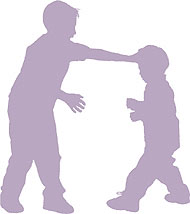Archives
Effects of bullying behavior serious for both parties, UB psychologist says
By PATRICIA DONOVAN
Contributing Editor
Although scientists say there is no proven way to stop peer aggression and bullying behavior in young children, a UB psychologist says that the consequences of the behavior are so serious for all parties involved that it should be stopped in its tracks by anyone who observes it.

Developmental psychologist Jamie M. Ostrov, assistant professor of psychology in the College of Arts and Sciences, studies the progression of subtypes of aggressive behavior in children.
"Parents and schools need to seriously monitor children's behavior very carefully in this regard and curtail it, whether the children are perpetrators or victims, 4 or 14, and whether the behavior is physical or relational, a form of peer aggression that uses the removal of relationship ("We won't play with you!") as the means of harm," Ostrov says.
"I am not being an alarmist in saying that, without intervention, both young aggressors and the children they intimidate can face very serious social and psychological adjustment problems, and even victims perpetrate aggression on others."
The author of several articles on this subject, Ostrov most recently was principal investigator for two observational studies of aggression, gender and social-psychological adjustment among preschool children published in the journals Early Childhood Research Quarterly and Social Development.
"Bullying is not the occasional poke in the ribs," he says. It is persistent abusive behavior marked by physical or relational aggression.
"It is commonly noticed among school-aged children," he says, "but my research collaborators at the University of Minnesota and I have demonstrated that frequent relational and physical aggression can begin as early as two-and-a-half years of age and may be a relatively 'stable' behavior during early childhood.
"If left untreated," he says, "it is likely to become more problematic and more serious as children move out of the early childhood period and into middle childhood and adolescence.
"I don't mean to suggest here that nothing works with young children," he says, "but specific interventions have not been studied enough to determine what does work across development and multiple contexts."
Ostrov says teachers and parents sometimes aggravate peer aggression by telling young children to "use words" instead of hitting and punching. This may provoke an aggressively domineering child to simply switch to different tools of manipulation and domination: exclusion, shunning, gossiping, spreading rumors and the like, common examples of relational aggression that can be terribly damaging.
"What ultimately needs to be addressed are the social-cognitive attributions and lack of empathy demonstrated by such children," he says, referring to the way in which they perceive, reason, judge and identify with others' feelings in social situations.
He points to long-term problems suffered by victims that range from comparatively low levels of psychological well-being and social adjustment to high levels of psychological distress and adverse physical and mental-health symptoms. He points out, too, that the results can be long-lasting.
The bullies themselves aren't in for a picnic, either.
Ostrov says that a strong correlation appears to exist between childhood aggression toward peers and legal or criminal troubles as an adolescent and adult.
A 1993 study by psychologist Dan Olweus of the University of Bergen, Norway, a leading expert in the field, for instance, found that 60 percent of children characterized as bullies in grades six to nine had at least one criminal conviction by age 24. A 1994 psychological survey of students in the Midwest also found that chronic bullies seem to maintain their behaviors into adulthood, diminishing their ability to develop and maintain positive relationships.
Victims of this behavior often fear school and consider it to be an unsafe and unhappy place, and a 2002 study by the National Education Association found that 160,000 children skip school in the United States each day because of intimidation by their peers.
Victimization tends to increase isolation, too, because other children don't want to lose status by associating with victims or run the risk of being bullied themselves, and children seldom report such behavior to parents or teachers.
"Some children, pushed to their limits, have lashed out at their tormentors in violent ways," Ostrov says, noting several school shootings, including those at Columbine and in Paducah, Ky., were committed by children who had been bullied for years prior to the killings, but didn't aim only at their aggressors.
"Bullying isn't a justification for violent revenge," he says, but we should understand that repeated social exclusion and physical victimization by peers may produce feelings of helplessness and fury in victims who may have impulse-control problems or violent or otherwise maladaptive personality traits. We know that when pushed hard enough, some retaliate violently.
"Considering all of this, bullying and peer-directed aggression should be addressed early in a child's life," Ostrov says.
He suggests that if their child is victimized, parents need to teach him or her effective strategies for dealing with the aggressor, and all children need to be trained to speak up on behalf of kids who are being bullied and against bullying itself.
"It is most important that parents demand that schools develop a comprehensive educational policy toward this kind of behavior," Ostrov says.
"The available developmental and clinical research suggests that, at least with school-age children, changing the school climate, working directly with the aggressive children to modify their social cognitions, and intervening when aggression occurs may be viable solutions for dealing with this major social problem."
